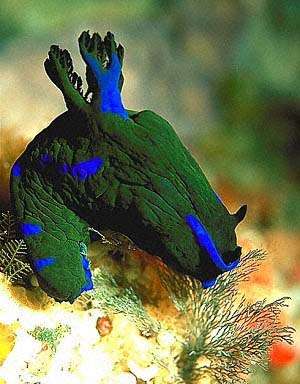
Tambja morosa
(Bergh, 1877)
Order: NUDIBRANCHIA
Suborder: DORIDINA
Family: Polyceridae
Subfamily: Nembrothinae
DISTRIBUTION
Tropical Western Pacific, and as far south as northern New Zealand.
PHOTO
Middle Arch, Poor Knights Islands, New Zealand, 12 metres. PHOTO: Ian Skipworth.
This is a large species of Tambja growing to about 70mm long. It is usually black with blue markings, but this dark green colour is found in specimens from the cooler waters of New South Wales, Australia, and northern New Zealand. Like all species of Tambja, it feeds on arborescent (plant-like) bryozoan colonies.
Reference:
• Baba, K. (1987) Two new green colored species of Tambja from Japan (Nudibranchia: Polyceridae). Venus, The Japanese Journal of Malacology, 46(1): 13-18.
• Bergh, L.S.R. (1877). Malacologische Untersuchungen. In: C.G. Semper, Reisen im Archipel der Philippinen, Wissenschaftliche Resultate. Band 2, Heft 11: 429-494, Pls. 54-57.
• Marshall, J.G. & Willan, R.C. (1999) Nudibranchs of Heron Island, Great Barrier Reef.
Rudman, W.B., 1999 (January 24) Tambja morosa (Bergh, 1877). [In] Sea Slug Forum. Australian Museum, Sydney. Available from http://www.seaslugforum.net/find/tambmoro
Related messages
Feeding Tambja morosa in New Zealand
May 17, 2007
From: Samuel Kemp
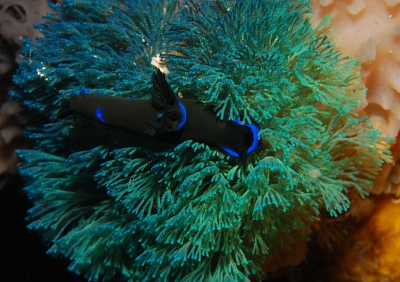
Hi Bill
Thought you might like these pictures of various Tambja species feeding. The pictures were all taken whilst diving Middle Arch, Poor Knight's Islands.
Locality: Middle Arch, Poor Knight's Islands, 10 m, New Zealand, Pacific, 04 February 2007. Photographer: Samuel Kemp.
Samuel Kemp
samuel_kemp@hotmail.com
Kemp, S.V., 2007 (May 17) Feeding Tambja morosa in New Zealand. [Message in] Sea Slug Forum. Australian Museum, Sydney. Available from http://www.seaslugforum.net/find/19908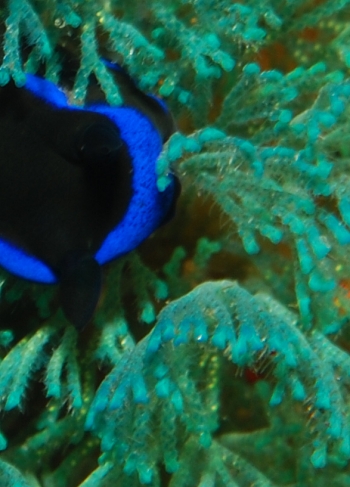
Dear Sam,
I have split your message into three, all of which show a different species of Tambja feeding on the blue plant-like bryozoan Bugula dentata. This one shows Tambja morosa
The other two show Tambja verconis [message #19419] and Tambja tenuilineata [message #19907]
Best wishes,
Bill Rudman
Tambja morosa from East Timor
December 11, 2006
From: Nick Hobgood
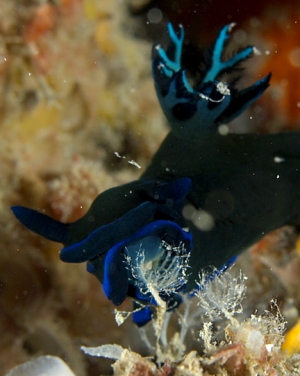
Concerning message #17192:
Dr. Bill,
We ran across this individual on a wall dive this last weekend. I have gone through all the Tambja species pictures you have on SSF and came up with the closest match - Tambja morosa. Is this correct ?
Locality: Rocky coastline, 12 metres, East Timor, Banda Sea, 03 December 2006, Rocky wall. Length: 50mm. Photographer: Nick Hobgood.
You can see that in the top image the slug is in the middle of taking a bite out of a food item. I hope this helps with the ID.
Thanks for your help!
Nick
nick.hobgood@mac.com
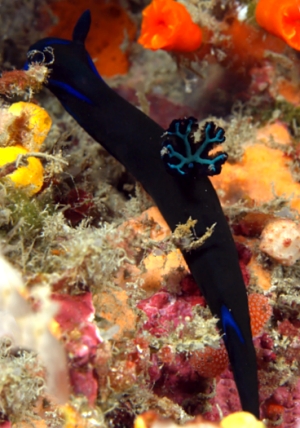
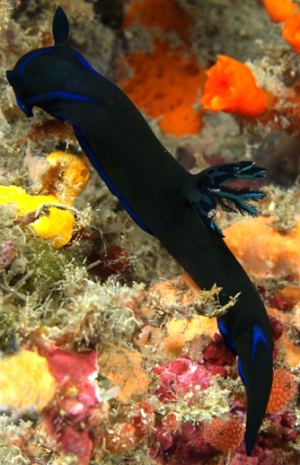
Dear Nick,
Although there is quite a bit of colour variation there doesn't seem to be any good reason to think there is more than one species in this group. Your animal in the top photo seems to be taking a bite on an arborescent bryozoan, which is the food of all species of Tambja.
Best wishes,
Bill Rudman
Tambja morosa from Bali
August 11, 2006
From: Johan Samsom
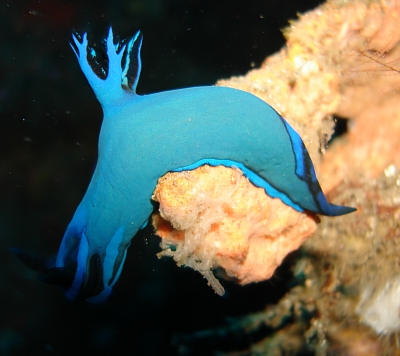
Hi
I found these nudibranchs at the so called Amed Wall in Bali, on a sandy bottom with corals on about 12 mtrs depth. Have not been able to find pictures of these on your website...
So perhaps you could either let me know the names of them and/or use the pictures as you wish.
Locality: Amed Wall, 12 mtrs, Bali, Indonesia, Asian Pacific, 18 July 2006. Length: dark blue about 5 cm little tuquoise about 3 cm. Photographer: Johan Samsom.
Best regards
Johan Samsom
Dragoer
Denmark
samsom@stofanet.dk
Samsom, J.A.M., 2006 (Aug 11) Tambja morosa from Bali. [Message in] Sea Slug Forum. Australian Museum, Sydney. Available from http://www.seaslugforum.net/find/17192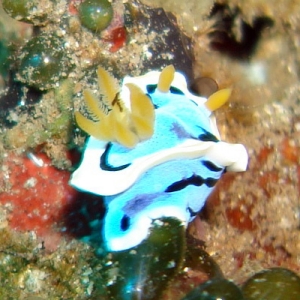
Dear Johan,
The large animal in the upper photo is a very pale variety of Tambja morosa. If you look at the other messages on the Forum about this species you will see quite a variation in background colouration. Looking at your lower photo however, I wonder whether your lighting may be affecting the colouration as well?
The smaller animal in the photo alongside is most probably Chromodoris elisabethina but the colours seem a bit unusual. The blue looks quite unnatural. In fact even the shadow of the gill is blue.
Best wishes,
Bill Rudman
Tambja morosa from Davao, Philippines
August 9, 2006
From: Carlos R. Munda
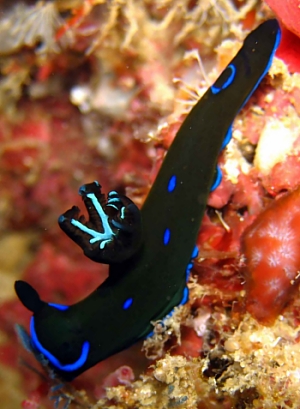
Are these common markings for Tambja morosa?
Locality: outer reef wall, 40 ft, Philippines, Pacific, 24 July 2006, reef wall. Length: 1.5 inches. Photographer: Carlos R. Munda, jr..
Thanks
Carlos R. Munda
c_munda@yahoo.com
Munda, C. R., 2006 (Aug 9) Tambja morosa from Davao, Philippines. [Message in] Sea Slug Forum. Australian Museum, Sydney. Available from http://www.seaslugforum.net/find/17237Dear Carlos,
This species seems to be quite variable in colour. Certainly in the tropics, this black form with bright blue markings is the most 'typical' colour form.
Best wishes,
Bill Rudman
Tambja morosa from the Philippines
July 8, 2006
From: Sébastien Lenglet
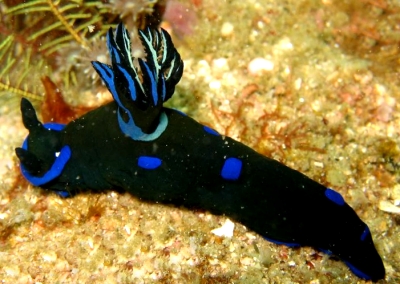
Hi Bill,
Here is a photo of Tambja morosa, black with nice electric blue spots ! It was taken in the Visayas, Philippines on march 2005.
Locality: Visayas, around 15 m, Philippines, Cebu sea, march 2005. Photographer: Sébastien Lenglet.
Regards,
Sébastien
lengletlameduse@yahoo.fr
Lenglet, S., 2006 (Jul 8) Tambja morosa from the Philippines. [Message in] Sea Slug Forum. Australian Museum, Sydney. Available from http://www.seaslugforum.net/find/17067Thanks Sébastien,
Best wishes,
Bill Rudman
Tambja morosa from Gold Coast, Queensland
June 10, 2006
From: Ian Banks
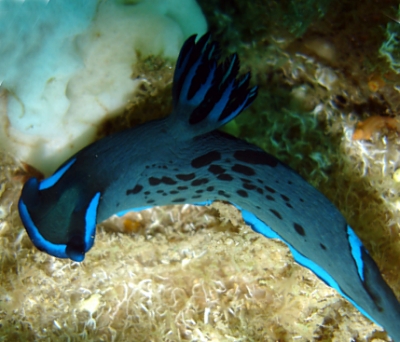
Bill,
This Tambja morosa was observed in a sheltered section near the surf zone on the Narrow Neck Artificial Reef. (Reef is constructed of 300 ton sand filled geotextile Containers) This is the only sea slug I have seen on this reef.
Locality: Narrow Neck Reef, Gold Coast, 4 metres, Queensland. Australia, Pacific Ocean, 2 January 2005, Artificial Reef in surf zone. Length: 6 cm. Photographer: Ian Banks.
Regards,
Ian
ianbanks@bigpond.com
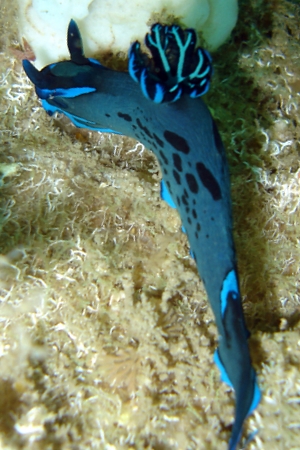
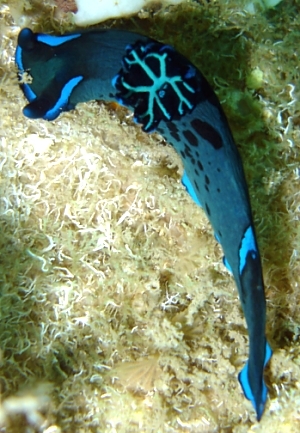
Dear Ian,
Thanks for this. It is a valuable confirmation of my earlier comment [message #10550] that in northern New South Wales and sthn Queensland [east coast Australia] the usual colour form of Tambja morosa is one with large black markings as in your animal.
You mention this is the only nudibranch you have seen on the artificial reef. Is it a fairly recent construction? Nuibranchs are usually found near their food, which varies in different groups from sponges, to ascidians, anemones, hydroids, and many other, often colonial, animals. If conditions are not quite right for their food, then the nudibranchs won't be there either.
Best wishes,
Bill Rudman
Tambja morosa? from Pemba, Tanzania
November 22, 2005
From: Wilhelm van Zyl
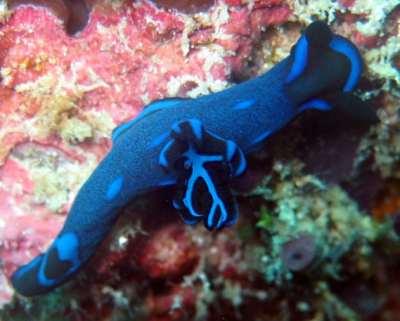
Hi Bill,
Here are some pictures of wat I believe is Tambja morosa from Pemba island on the East African coast.According to the Factsheet the distribution is around the Tropical Western Pacific. I saw this species on quite a few dives between about 10 and 15m water depth.
Locality: Pemba island, Zanzibar, Tanzania. Indian Ocean. Depth: 10 - 15 m
Length: 6 cm. 2 October 2005. broken Coral reef. Photographer: Wilhelm van Zyl
Regards
Wilhelm
diving@cyberdale.co.za
Van Zyl, F.W., 2005 (Nov 22) Tambja morosa? from Pemba, Tanzania. [Message in] Sea Slug Forum. Australian Museum, Sydney. Available from http://www.seaslugforum.net/find/15252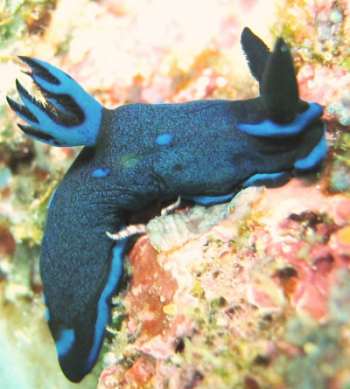
Dear Wilhelm,
I am not sure how many blue marked species of Tambja there are. Baba (1987) described Tambja kushimotoensis, with a green background colour, but I suspect a species can vary from green to black in background colouration. It is possible the blue markings on the gills are an indication of different species but I think some work needs to be done on the anatomy to be sure. I have left a variety of colour forms as Tambja morosa on the Forum until Marta Pola has finshed her stuides, Hopefully she will adress the T. morosa - T. kushimotoensis question. Certainly blue coloured animals have been reported from the western Indian Ocean region and Yonow (1991) reports an animal, similar in colour to yours but with a green background colour, from Mauritius. Another complication is that Charles Eliot (1904) described a species, Nembrotha caerulea, from east Africa. Unfortunately the only information on its external colour was that it was 'blue'. From his radular description this was a species of Nembrotha rather than Tambja so it would be nice to know something about the radula of your 'blue' animals.
All I can say is that this group of nembrothids remains a 'work in progress'
-
Baba, K. (1987) Two new green colored species of Tambja from Japan (Nudibranchia: Polyceridae). Venus, The Japanese Journal of Malacology, 46(1), 13-18.
-
Eliot, C.N.E. (1904) On some nudibranchs from East Africa and Zanzibar. Part V. Proceedings of the Zoological Society of London, 1904(2), 83-105, Pls.3-4.
-
Yonow, N & Hayward, P.J. (1991) Opisthobranches de l'Ile Maurice, avec la description de deux especes nouvelles (Mollusca: Opisthobranchia). Revue francaise d'aquariologie, 18(1), 1-30, Figs1-13.
Best wishes,
Bill Rudman
Re: Tambja morosa from Sulawesi
April 16, 2005
From: Francesco Ricciardi
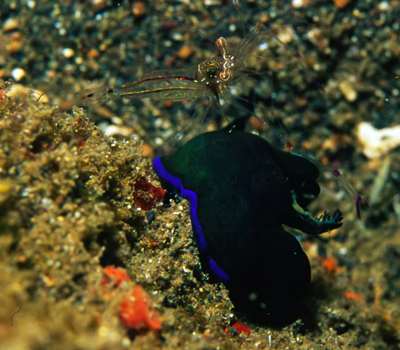
Dear Bill
This is a photo of Tambja morosa from Lembeh Strait in association with a cleaning shrimp, I suppose.
Lembeh Strait, Indonesia. Depth: 15 m. Photographer: Francesco Ricciardi
Regards
Francesco Ricciardi
francesco.ricciardi@unimi.it
Ricciardi, F., 2005 (Apr 16) Re: Tambja morosa from Sulawesi. [Message in] Sea Slug Forum. Australian Museum, Sydney. Available from http://www.seaslugforum.net/find/13480Dear Francesco,
Not every time you find a shrimp on a nudibranch is it an example of an association. It looks rather big to be permanently associated with the Tambja, but strange relationships have been reported
Best wishes,
Bill Rudman
Tambja morosa from southern Queensland
November 12, 2003
From: Gary Cobb
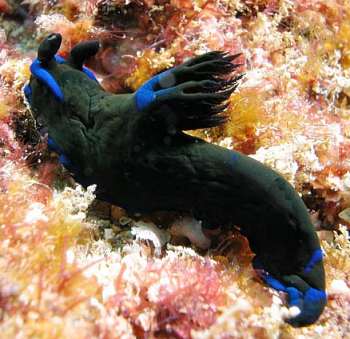
Hi Bill,
Please find attached a photo of Tambja morosa I found off Mooloolaba, Queensland, Australia at a site called Coles Hole, 20m depth, 45mm long, 20 degree water.
Cheers
Gary Cobb
gary@cobb.com.au
Cobb, G., 2003 (Nov 12) Tambja morosa from southern Queensland. [Message in] Sea Slug Forum. Australian Museum, Sydney. Available from http://www.seaslugforum.net/find/11331Thanks Gary
Bill Rudman
Tambja morosa - new locality?
July 26, 2003
From: Ron Greer
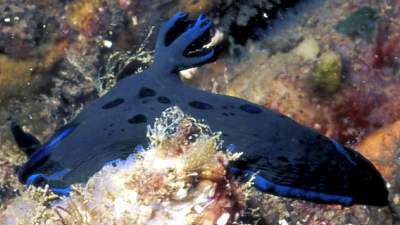
Hi Bill,
I was checking your site and looking at Tambja morosa when I realized that there were no records from New South Wales. Thought you may wish to include this (very average)image from Fly Point, Port Stephens, NSW. Taken in 12m, 1990 and about 50mm long.
Like many sea slugs found in Port Stephens, it is probably an unlucky arrival on the eastern current - I have seen only this single example in 15 years diving in the area.
Regards,
Ron Greer
diveimage@netspace.net.au
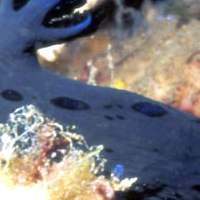
Thanks Ron,
Yes T. morosa is a rare visitor to the coast of New South Wales. Interestingly it is often this colour with a green or grey background and blackish spots. Your photo nicely shows that the black spots are really blue with a black border. This nicely fits with the discussion I had with Todd Garthwaite over his photos from Taiwan of 'T. kushimotoensis' which I suspect is a colour form of T. morosa.
Best wishes,
Bill Rudman
Tambja kushimotoensis from Taiwan
July 24, 2003
From: Todd Garthwaite
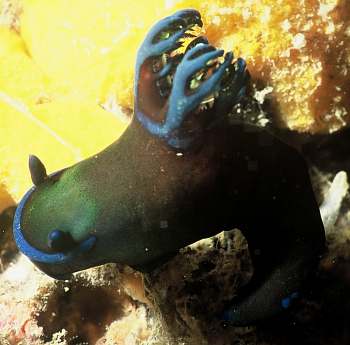
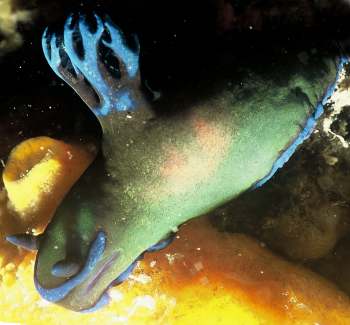
Hi Bill,
Here are several shots of two different specimens of what Ono Atsushi identifies in his book, Opisthobranchs of Kerama Islands, as being Tambja kushimotoensis Baba, 1987. However, this type is listed on SSF's Species List as Tambja morosa. Either way, this species is a rather exotic find for the N.E. Coast of Taiwan. In addition to these 2 specimens, not far away I also came across a juvenile specimen of the same species. Incidentally, this dive site is rich in lemon calcite sponges (Leucetta lemon).
Site: "The 2nd Wall", FanZai Ao [Barbarian Cove]
(N.E. Coast, Taipei County, Taiwan),
13 July 2003, 10:48am
Depth: 22.5 meters. Water temp.: 27 deg. Celsius. Size: approximately 60+ mm.
Stay golden.
Peace, love, & nudis
Todd Garthwaite
typhoontoddy@yahoo.com
Garthwaite, T., 2003 (Jul 24) Tambja kushimotoensis from Taiwan. [Message in] Sea Slug Forum. Australian Museum, Sydney. Available from http://www.seaslugforum.net/find/10503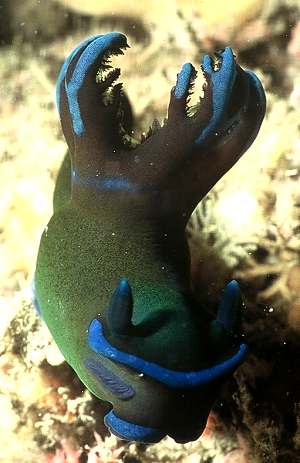
Dear Todd,
Thanks for these photos. I think they help to resolve my feelings about colour variation in Tambja morosa. Baba's T. kushimotoensis was described as green with colour markings much as in your photos, except that he mentioned a few scattered bright blue spots, much as in the animal from New Zealand I have identified as T. morosa. Marshall & Willan (1998) suggest that T. morosa can be distinguished by its black background and bright blue lines while T. kushimotoensis has a green background with blue spots, but the photos on the Forum suggest there is a continuum in background colour from green to black and in blue spots and lines. Your photos certainly show the background colour can vary from black to green in one animal.
In your message about T. sagamiana I noted the interesting sensory patch on the head which could be seen in one of your photos. This is also very clear in your photos of T. morosa so I have posted close-ups in a separate message.
• Baba, K. (1987) Two new green colored species of Tambja from Japan (Nudibranchia: Polyceridae). Venus, The Japanese Journal of Malacology, 46(1): 13-18.
Best wishes,
Bill Rudman
Head & sensory organs of Tambja morosa
July 24, 2003
From: Bill Rudman
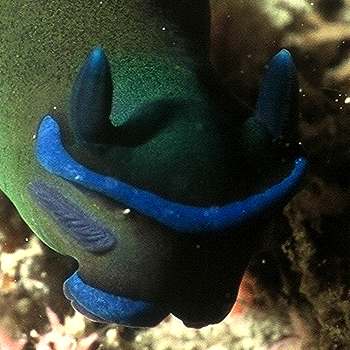
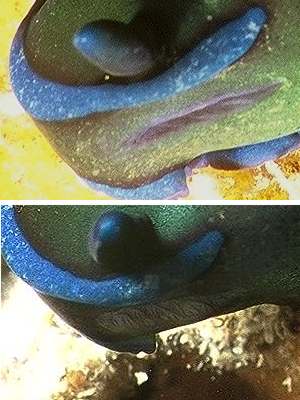
In Todd Garthwaite's recent messages concerning Tambja sagamiana and T. morosa from Taiwan, the characteristic 'sensory pits' on the side of the head are very well illustrated so I have posted here close-ups from his photos of T. morosa.
In the upper photo, below the rhinophore there is a long black ridged structure. Usually all we see is a dark line, or groove along the side of the head, and so it is often overlooked as another of the many longitudinal ridges found on the body of these nudibranchs. In preserved specimens it is even more difficult to see. In the middle photo the sensory organ is 'half open' and in the lower photo it is fully 'everted' to show its structure of compound ridges.
The function of this organ has, to my knowledge, not been investigated, but it is heavily innervated, so I have little doubt that it has a chemosensory function, used by the animal to locate colonies of its bryozoan food.
Best wishes,
Bill Rudman
Tambja morosa swimming
April 5, 2003
From: Sarah Heaney
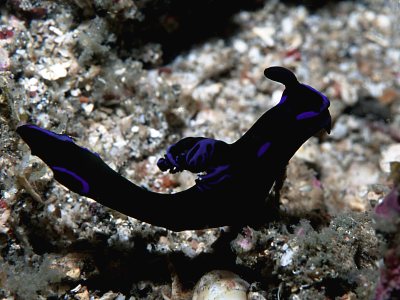
Hi Bill,
I thought you might like a photo of Tambja morosa swimming. It was taken at Nudi Retreat, Lembeh Strait, Indonesia on 24/10/02.
Regards,
Sarah
sarahlheaney@hotmail.com
Heaney, S., 2003 (Apr 5) Tambja morosa swimming. [Message in] Sea Slug Forum. Australian Museum, Sydney. Available from http://www.seaslugforum.net/find/9561Thanks Sarah,
Quite a lot of these long-'tailed' nudibranchs can swim by this vigorous lateral movement of the body - simultaneously bending the head and tail to one side, then to the other. Not a very directed way of swimming but a good way to move away from somewhere quickly
Best wishes,
Bill Rudman
Tambja morosa from Vanuatu
March 23, 2003
From: Vinka Stenhouse
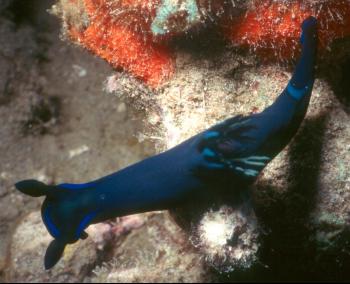
Hello Bill
Could you please confirm that this nudibranch is a Tambja morosa. We saw a number of them, always at a depth of about 10 metres at Espiritu Santo, Vanuatu. 1997. Photo: James Stenhouse
Regards
Vinka
vinkas@oceanaphotography.com
Dear Vinka,
Yes this is Tambja morosa
Best wishes,
Bill Rudman
Juvenile of Tambja sagamiana?
January 21, 2003
From: Tomoki Ueda
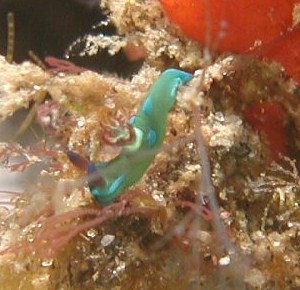
Hello Bill,
It's a photograph taken in Secret Bay [Gilimanuk Bay], Bali, Indonesia. The length is 8mm-10mm and the depth is 3m. My friend said this species is a juv. of Tambja sagamiana. Is it really?? I think it's a another one. But I can not find out the name of this. Please let me know the name of this species.
Thanks,
Tomoki Ueda
sales@papasdive.com
Ueda, T., 2003 (Jan 21) Juvenile of Tambja sagamiana?. [Message in] Sea Slug Forum. Australian Museum, Sydney. Available from http://www.seaslugforum.net/find/8918Dear Tomoki,
Its a bit hard to identify juveniles, and until we know more about colour variation in different species, we can never be sure. I very much doubt that this could ever convert inot the adult colour form of T. sagamiana. It is possibly the animal I have on the Forum as Tambja cf. verconis, or it could even be a Tambja morosa. If you look at Mary-Jane Adams's message, she has a photo with very similar blue and green markings.
Sorry I can't be more definite,
Best wishes,
Bill Rudman
Tambja morosa laying eggs
December 20, 2002
From: Mary Jane Adams
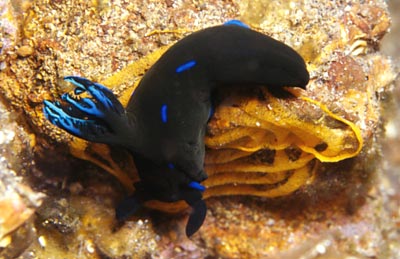
Hi Bill,
Tambja morosa is fairly common in Lembeh Strait, Sulawesi Island, Indonesia. I found this one laying eggs on a night dive. It was about 3-4cm long.
Divesite: Nudi Falls
Depth: 5 meters
Date: November 23, 2002
Best regards,
Mary Jane
divepng@yahoo.com
Adams, MJ., 2002 (Dec 20) Tambja morosa laying eggs. [Message in] Sea Slug Forum. Australian Museum, Sydney. Available from http://www.seaslugforum.net/find/8649Thanks Mary Jane,
Best wishes,
Bill Rudman
Tambja morosa from Indonesia
September 27, 2002
From: Sabine Noack
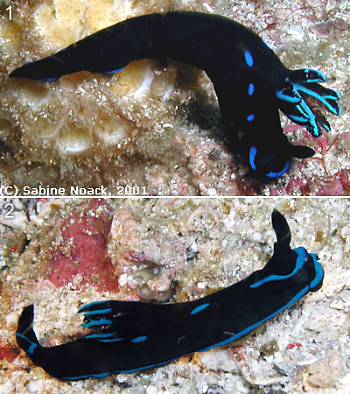
Dear Bill,
We found these 4 differently colored Tambja morosa at the same dive site (Pulau Pisan, Horseshoe Bay, Rinca , Indonesia).
The date/time was 29 September 2001 around 15:00
• Number 1 was found in ~25m, it was ~5cm long, black with bright blue markings. The color around the gills was bright green. It was crawling on the sandy bottom.
• Number 2 was found in ~20m, it also was ~5cm long, black with blue-green markings (gills, spots and line around the mantle had the same color). It was crawling across a sandy patch on the reef.
• Number 3 was found in ~15m, it was ~4cm long. Its lower sides were dark green, the back was black and the markings were all in the same blue-green color. It was crawling across a hard coral.
• Number 4 was found in ~7m, it was ~5cm long and very very slowly crawling across a big tunicate (Polycarpa aurata). It was black with bright blue dots, a bright green ring at the bottom of the gills. The color on the inside of the gills was green, the outside was blue.
Regards,
Sabine
dive@snoack.de
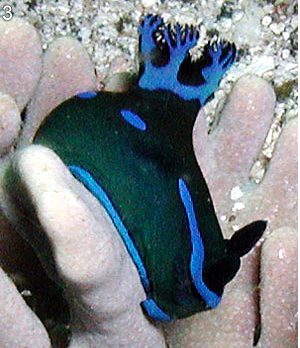
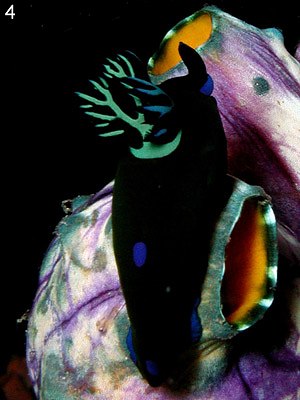
Thanks Sabine,
I have often wondered about the small discrepancies in color you find in this 'species' but have been unable to find any consistent differences.
Best wishes,
Bill Rudman
Tambja morosa from Sulawesi
June 10, 2002
From: Mary Jane Adams
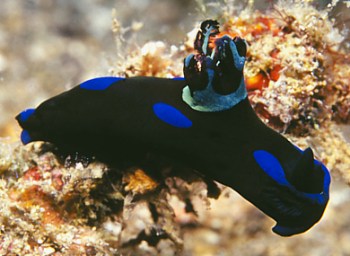
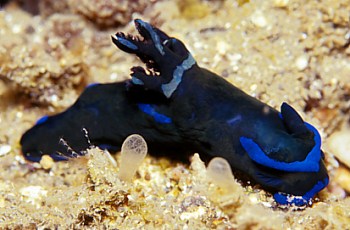
Hi Bill,
This is what Tambja morosa looks like in Lembeh Strait, Sulawesi, Indonesia. Both slugs where photographed at Police Pier, a sand slope with reef patches. The lower one, missing a right rhinophore was shot on April 10, 2002. The upper one, missing most of its left rhinophore, was shot on April 17, 2002. Both were about 25-30mm long.
Best regards,
Mary Jane
divepng@yahoo.com
Adams, M J., 2002 (Jun 10) Tambja morosa from Sulawesi. [Message in] Sea Slug Forum. Australian Museum, Sydney. Available from http://www.seaslugforum.net/find/6887Thanks Mary Jane,
Bill Rudman
Tambja morosa from Papua New Guinea
November 12, 2001
From: Marli Wakeling
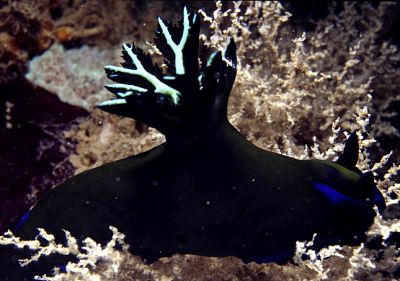
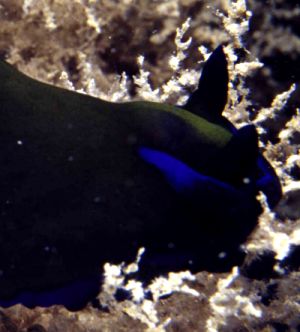
Hi Bill,
This is the Tambja morosa often found beside Tambja sp.4 from Kavieng Harbour, Papua New Guinea.
Location: The Old Slipway, Kavieng, Papua New Guinea
Depth: 8 metres
Length: 20 cm
Date: August, 2001
Photograph: Marli Wakeling
Marli
scubamarli@excite.com
Wakeling, M., 2001 (Nov 12) Tambja morosa from Papua New Guinea. [Message in] Sea Slug Forum. Australian Museum, Sydney. Available from http://www.seaslugforum.net/find/5367Thanks Marli,
It's possible that there is more than one black species with blue markings being called N. morosa, some having light markings on the gills and others not.
Best wishes,
Bill Rudman
Tambja cf morosa from the Philippines
January 5, 2001
From: Erwin Koehler
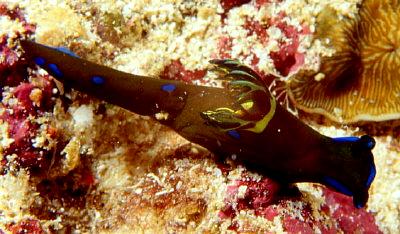
Dear Bill,
This photo was made by Franco de Lorenzi [Email cratena@libero.it]
Philippines, Cebu Island, Moalboal, divesite "Visaya", size 7 cm, depth
28 m, August 23, 1999.
Erwin
Medslugs.Koehler@t-online.de
Koehler, E., 2001 (Jan 5) Tambja cf morosa from the Philippines. [Message in] Sea Slug Forum. Australian Museum, Sydney. Available from http://www.seaslugforum.net/find/3475Dear Erwin,
I think this is a colour form of Tambja morosa, but I have not had a chance to look at the anatomy of an animal with this colour pattern
Best wishes,
Bill Rudman.
Tambja morosa from Queensland
October 8, 2000
From: Stuart Hutchison
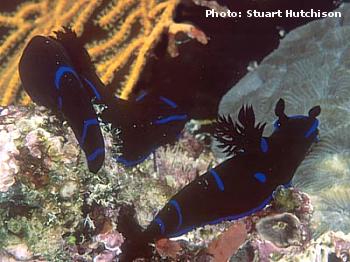
Dear Bill,
Here are a couple of Tambja morosa from the Great Barrier Reef (Australia) just off Townsville. It's not the best shot of all time, but you can at least tell what they look like.... Both animals were found together at about 7m on a coral bommie and were about three inches long in March 1998.
Stuart
hutchco@tpg.com.au
Hutchison, S., 2000 (Oct 8) Tambja morosa from Queensland. [Message in] Sea Slug Forum. Australian Museum, Sydney. Available from http://www.seaslugforum.net/find/3139Dear Stuart,
Thanks. It is nice to have a good photo of a typical black animal to compare with the green form from New Zealand.
Bill Rudman.
Tambja morosa from Thailand
April 10, 2000
From: Narongpon Sittithaweepat
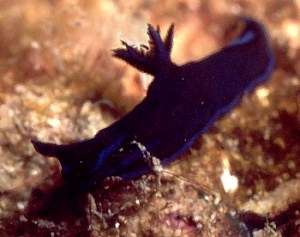
Dear Bill
I am not sure if this specimen is Tambja morosa. I found it at Surin Island, Thailand. So could you please identify it for me.
Thank you for your kindness again
Narongpon
chromodorid@thaimail.com
Sittithaweepat, N., 2000 (Apr 10) Tambja morosa from Thailand. [Message in] Sea Slug Forum. Australian Museum, Sydney. Available from http://www.seaslugforum.net/find/2236Dear Narongpon,
Yes your animal is Nembrotha morosa. Any further information on locality, size and date, for any of your animals would make your photos a valuable part of the scientific record.
Your black animal is a much more 'normal' colour than the greenish colour of the New Zealand animals already on the Forum.
Best wishes,
Bill Rudman.
Re:Tambja morosa in New Zealand
April 2, 1999
From: Ross Armstrong
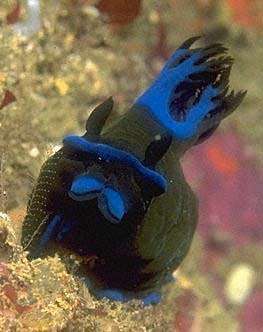
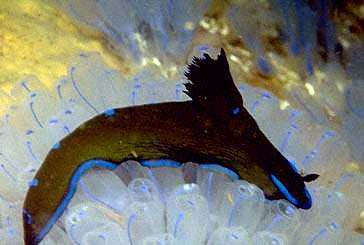
Hi Bill
I see that Ian Skipworth has sent you an excellent photo of this nudibranch. Ian has got a very good web-site with some excellent photos including some quite rare nudibranchs which I am yet to find. In regard to your comment about the colour my own experience is that they are normally a much darker green, almost black.
My experience is that they are quite common at the Poor Knights this year but reasonably rare in previous years. This may just be my
previous inability to find them.
I have attached two of my own images. The one of Tambja on the ascidian was not posed. It was photographed in Bernie's cave near Middle Arch at the Poor Knights late last year. There were several Tambja morosa in the cave. There was also a lot of ascidians. When I first photographed the
particular nudibranch it was not on the ascidians. However the nudibranch was moving along reasonably quickly for nudibranchs and happened to crawl (if that is what nudibranchs do) over the ascidians. I thought it was a good photo opportunity.
I had to hurry to get some photos before it reached the other side. I am fairly sure it was not feeding but just passing through, however that was based on an assumption at the time. None of the other Tambja morosa were on the ascidians. There was also four or five Tambja verconis at the entrance to the cave.
We have had a lot of the more uncommon nudibranchs at the Poor Knights this summer. Possibly something to do with La Nina?
cheers
Ross Armstrong
Note the change in e-mail address. I am setting up a web site www.oceanwildlife.com - not a lot of nudibranch photos though.
ross@oceanwildlife.com
Armstrong, R., 1999 (Apr 2) Re:Tambja morosa in New Zealand. [Message in] Sea Slug Forum. Australian Museum, Sydney. Available from http://www.seaslugforum.net/find/753Dear Ross,
Thanks for the photos. It is an intersting picture with the bryozoan-eating Tambja on the ascidians. When I first saw your photo I thought it is either posed or we have an ascidian-feeding species of Nembrotha mimicking Tambja morosa! It's a good example of how important it is to treat photos of apparent feeding episodes with caution.
Good luck with your website. I look forward to additions. I must say I love the ray photo and the way you have rainbow coloured the hydroids.
Best wishes,
Bill Rudman.
Tambja morosa from New Zealand.
January 24, 1999
From: Ian Skipworth

Hi
Yet another slug I'm afraid. The attached image of Tambja morosa was snapped at Middle Arch at New Zealand's Poor Knights Islands in about 12 metres of water.
We see these critters fairly commonly at the Poor Knights.
Regards,
Ian
Ian Skipworth
Auckland, New Zealand
Skip's Underwater Image Gallery
ianskip@ihug.co.nz
Skipworth, I., 1999 (Jan 24) Tambja morosa from New Zealand.. [Message in] Sea Slug Forum. Australian Museum, Sydney. Available from http://www.seaslugforum.net/find/508Dear Ian,
Thanks very much. Don't be afraid of sending photos. The New Zealand fauna is very interesting as it has its endemics, others that it shares with southern Australia, and a third group, including Tambja morosa, which are widespread tropical species. So photos from New Zealand are valuable in many ways. As well as informing those with no knowledge of the NZ fauna, they also give us a better understanding of the range of some of the more common tropical species. Is Tambja morosa always this deep green colour in New Zealand? In tropical waters it usually has a black background colour. Your animal is feeding on an arborescent bryozoan (perhaps Bugula sp). Species of Tambja feed exclusively on arborescent bryozoans
Best wishes,
Bill Rudman.
